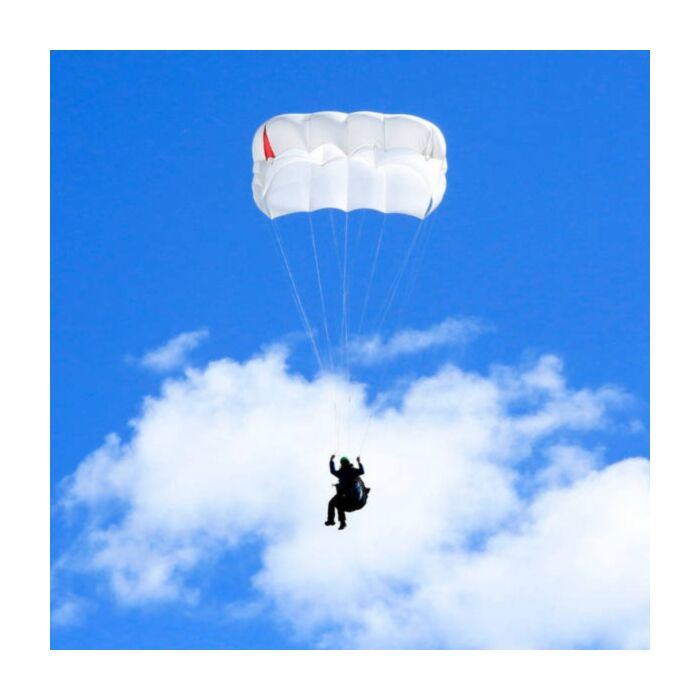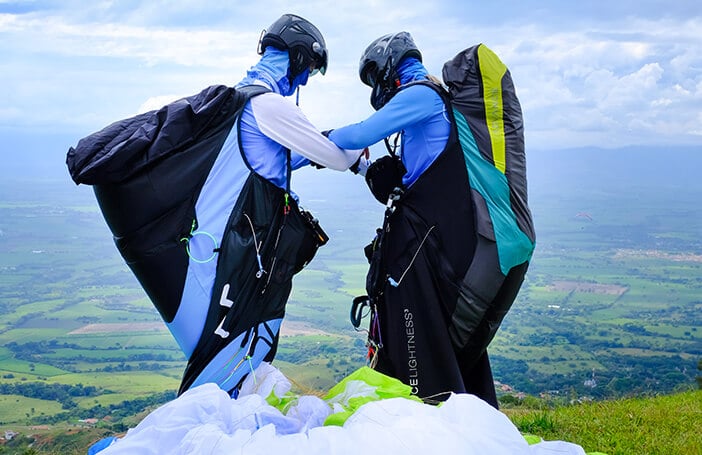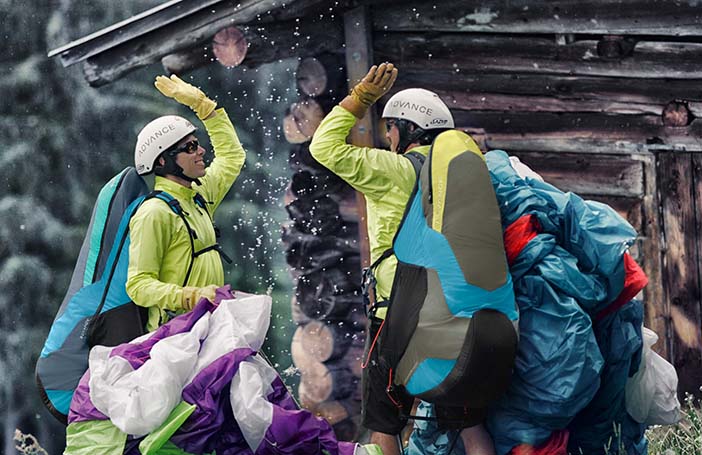
Charly DIAMONDcross ST light (PAST MODEL)
Select all options to view stock availability

Superseded by the Charly Targetcross ST Light
Light square paragliding emergency reserve parachute system with optional steering.Technical data
| Size | 100 | 125 | 160 | 160T | 220 |
|---|---|---|---|---|---|
| Model | DC 100 ST | DC 125 ST | DC 160 ST | DC 160 ST Tandem | DC 220 ST Tandem |
| Max. load | 100 kg | 125 kg | 160 kg | 160 kg | 220 kg |
| Surface | 25.2 m² | 30.7 m² | 41.0 m² | 41.0 m² | 59.2 m² |
| Weight¹ | 1170 g | 1390 g | 1780 g | 1850 g | 2520 g |
| DR² (max load) | 4.7 m/s @ 100 kg |
4.5 m/s @ 125 kg |
4.5 m/s @ 160 kg |
4.5 m/s @ 160 kg |
4.5 m/s @ 220 kg |
| DR² (min load) | 3.6 m/s @ 70 kg |
3.5 m/s @ 85 kg |
3.5 m/s @ 110 kg |
3.5 m/s @ 110 kg |
3.5 m/s @ 160 kg |
| Volume | 3900 ccm | 4700 ccm | 5300 ccm | 5300 ccm | 7300 ccm |
| Certification | EN, LTF | EN, LTF | EN, LTF | EN, LTF | EN, LTF |
| Art.-N°. | HFa195/100 | HFa195/125 | HFa195/160 | HFa195/160T | HFa195/220 |
¹ Weight includes inner container and harness connection (bridles).
² DR: Descent Rate in metres per second (m/s) at the stated load in kilograms (kg).
Package
- Reserve
- Inner container
- Reserve bridles
Separate reserve bridles not required.
DIAMONDcross ST light: steerable square reserve
Light square (cruciform) paragliding emergency reserve parachute system with optional steering.
The Charly DIAMONDcross ST light presents three main innovations:
- It has a defined forward speed in diagonal direction with the effect of a significantly reduced sink speed. This results on the one hand in a higher aspect ratio compared to conventional cruciform canopies, those propulsion mainly takes place towards one side, and on the other hand in the asymmetrical air flow of the convex sides of the DIAMONDcross canopy, thereby receiving an ascending forced optimised profile.
- The horizontal movement, which is typical for every modern round canopy and cruciform canopy, can be steered for the DIAMONDcross ST in a certain direction, if required. Obstacles like e.g. power lines can thus be avoided and an emergency landing field can be precisely approached with a glide ratio of ca. 1:1.5. There are no disadvantages for the DIAMONDcross ST compared with conventional cruciform canopies.
- The DIAMONDcross has different line lengths which has the effect that the strips of the canopy don't lie on top of each other when packing the canopy. This diversification causes an easier air inlet when opening and thus an increased opening speed compared to conventional cruciform canopies. The packing of the DIAMONDcross is not more time-consuming or more complex than for a normal cruciform canopy.
The superlight DIAMONDcross ST thus combines the low packing effort of round- and cruciform canopies with the controllability of Rogallo reserve systems. For the DIAMONDcross, there is no risk of a “down plane” immediately after release, that is typical for Rogallo reserve systems even after pre-braking if they open with the top downwards.
The concept of the DIAMONDcross ST works without pre-braking and therefore the system remains very easy to handle and is reliable.
Further safety aspects
- There are no potential hazards in consequence of the steerability: The twisting of the lines, which often is unavoidable when using a controllable reserve system, doesn't cause any special risks. The DIAMONDcross ST can also be controlled in twisted condition. The red colour marking on the front head indicates clearly visible the flight direction for the pilot.
- No risks can arise by excessive pulling or by non-use of the brake handles. There is no risk of stall. A pulling of the brakes is not required when landing, as the canopy already is trimmed at minimum sink rate. The forward speed also reduces significantly the risk of spine compression during the landing.
- The long suspension lines of the DIAMONDcross and the symmetric shape of the canopy lower the risk of causing a collapse with the reserve system and the glider.
- Forward movement and low sink rate reduce in addition the risk of a side slip between the reserve system and the glider, and therefore higher sink rates.
- A short stall phase of the DIAMONDcross after opening prevents the formation of a "downplane"-position. The DIAMONDcross merges without the help of the pilot after a short independent stall phase in an easy, very stable and swing-free forward flight.
- The special design of the inner container, optimized with the help of Tom Grabner's G-Force trainer ensures a safe deployment of the DIAMONDcross with low effort needed. Especially with regard to inconvenient pulling directions when deploying the reserve system. Therefore we absolutely recommend to use the original approved container with the reserve system and to adapt the reserve handle of the harness to the container by an authorised service company.
- The inner container has a separate space for the suspension lines. The canopy will only be deployed after aspect ratio of the suspension lines, which enables a fast and controlled opening. The risk of a cravat of reserve system and glider is therefore reduced.
- The superlight cruciform canopy from Charly's product designer Tom Grabner has been registered for patent and certified in four sizes.
Videos
Videos about the Charly DIAMONDcross ST light square (cruciform) steerable reserve parachute.
DIAMONDcross ST: Tests above solid ground
An advantage compared to conventional cruciform canopies is the optional steering.
DIAMONDcross ST presentation at Thermik 2017
Tom Grabner explains the optionally steerable reserve system, showing action-videos.
Charly DIAMONDcross ST packing instructions
Detailled video for packing a steerable Charly DIAMONDcross reserve system.
DHV Interview with DIAMONDcross developer
Interview with DIAMONDcross developer Tom Grabner.
New tests performed for opening safety of the DIAMONDcross
Author and test pilot: Tom Grabner
Already during the development of the DIAMONDcross, the topic "entanglement of the rescue system with the main glider" was crucial for diverse product details, which have been certified with additional tests far above certification criteria during the summer.
The most dangerous situations for a rescue system becoming entangled with the main glider are SAT-like rotations after tangling up. This was simulated by holding collapses.
In contrast to the urgent recommendation of DHV, to powerfully throw the parachute towards your legs to prevent the rescue becoming entangled with the main glider in such situations, the parachute has been deployed after the release out of the harness when tested, to simulate the "worst case".
The aim of the test was to prove that the DIAMONDcross reliably opens also in this situation. Particularly in such an exceptional state like rescue deployment in a stressful situation it might be possible that the pilot is not able to react correctly.
The overall concept of the DIAMONDcross has integrated and considered these aspects of practice at the best. This makes the DIAMONDcross the rescue system with the highest opening safety!
DIAMONDcross rescue system test videos:
As shown in the videos of the tests, the construction features of the DIAMONDcross are absolutely decisive for a safe function of the rescue system in case of emergency, although they are not decisive for certification:
1) Conception of long liners
The lines of the DIAMONDcross are longer, so that the opening of the rescue system does happen in the same radius of the main parachute and not in the area of the lines.
The line length of the rescue system hardly has a negative impact on the opening time in the rotation, as the package immediately separates rapidly from the pilot.
2) Design of the inner container
The inner container has a separate closure of the canopy, so that the lines are stretched before the canopy opens.
This triggers a controlled release with a high separation of the parachute package. The parachute package which still has not opened rotates in the same direction as the main parachute while the lines are stretching. Only when the lines are stretched and with an appropriate safety distance to the main parachute, the canopy will release from the container.
3) Packing procedure
By a special kind of packing, the DIAMONDcross opens instantly already on the base, before the peak has left the inner container. The higher the rotation speed, the faster the opening of the way of packing for the DIAMONDcross.
This will be reached by a separate folding of both pre-sorted sides (instead of the usual long S-fold*), as well as a tube inner container, in which the parachute is packed in small S-folds.
4) Line geometry
The different line lengths (due to its construction by controllability) fan out the panels. In this way several gaps occur for an instantaneous air circulation of the parachute base after leaving the inner container.
Entanglement
Entanglement of the rescue system with the main glider – this is a problem of conventional rescue systems, which is not detected in certification:
Simultaneous releasing of lines and canopy
If lines and canopy are set free at the same time, as for many integrated harness containers, the rescue system tends to open faster. This however effectuates in a rotation, when pulling it, the rescue system may open partially directly next to the pilot, thus the rescue system decelerates due to the increased air resistance and thereby is very likely blown in the lines of the main glider. Not without reason, the opening aids (the small parachutes on the container) which were quite famous meanwhile have disappeared from the market.
Short lines
A rescue system with short lines leads to a faster opening when throwing the rescue system during straight flight, but prevent in a rotation in case of emergency the sufficient separation of the rescue system and the main glider.
Long S-fold
When packing the rescue system, the long S-fold is still practised by habit. Especially in rotations, the rescue system can wrap around the line bundle, whereby the air circulation of the parachute's base significantly slows down. Specifically for low activation altitude this can provoke that the rescue system does not catch the pilot before the crash.
* A long S-fold is the longitudinal ,,S''-shaped folding of the canopy when packing the rescue system.
** A short (vertical) S-fold is the cross side ,,s''-shaped folding of the canopy for stowing in the container
FAQ
Do I have to disconnect my glider when opening the DIAMONDcross?
No. Although if the pilot reacts in a passive way, the DIAMONDcross works perfectly. The risk of a side slip is very low for a DIAMONDcross. Nevertheless, the glider should be disconnected – if possible – from all reserve systems, no matter whether they are steerable or not. The disconnection can be made by separating the glider from the carabiner, as in this case, an automatic separation system for the speed system is absolutely essential. Further opportunities are rapid separation carabiners or cutting off the main lines by means of a jack knife.
With the Finsterwalder Quick-Out carabiners, the disconnection is very simple.
As you can't make general statements about how the glider reacts after reserve deployment and every reserve system is always influenced by the residual resistance of the glider, a complete disconnection of the glider can only be an advantage – also if a disconnection is not absolutely necessary for the DIAMONDcross.
Downloads
| Condition | New |
|---|---|
| Model Status | Past model |
Standard UK delivery - £3.95 / FREE on orders over £100.
Outside the UK - delivery calculated at checkout (based on the total order value and your delivery address).
We use Royal Mail, Parcelforce Worldwide and other courier companies (e.g. DHL, DPD) depending on shipment value, weight, destination etc.
For more information, please view our order and delivery FAQs page.
If you are not 100% satisfied with your order, you have 14 days from the day of delivery to request a refund.
Delivery costs will not be refunded and you will be responsible for the delivery cost to return the order.
For more information, please read our returns and exchanges policy.



